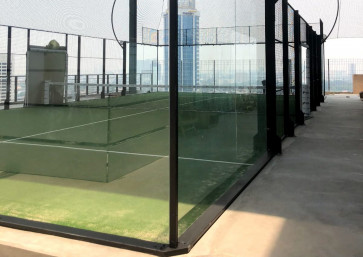Popular Reads
Top Results
Can't find what you're looking for?
View all search resultsPopular Reads
Top Results
Can't find what you're looking for?
View all search resultsRedefining kitsch, the democracy of visual art
Eeewh, that's ugly! How many times does such a thought pop up during one's day roaming the city streets? From shocking-colored shops that blind your eyes and plastic palm trees in a country that real ones could surely survive in, to Roman and Greek statues displayed as tacky status symbols by the Indonesian nouveau riche
Change text size
Gift Premium Articles
to Anyone
E
eewh, that's ugly! How many times does such a thought pop up during one's day roaming the city streets?
From shocking-colored shops that blind your eyes and plastic palm trees in a country that real ones could surely survive in, to Roman and Greek statues displayed as tacky status symbols by the Indonesian nouveau riche.
As we explore the city, we probably end up having so many of these thoughts we have to ignore them.
Two decades ago, such eyesores might have once been something trendy and aesthetically pleasing.
Try criticizing those things in front of your grandparents and prepare to receive a scolding stare, accompanied by a defensive proclamation of "What's wrong? They're beautiful!"
"What was previously known as kitsch can now be trendy and vice versa," art curator Amir Sidharta said.
But, as what is considered as having aesthetic value evolves, "kitsch" is also being redefined.
Kitsch, a word which originated in 19th century Germany, when the art market there was flooded with new bourgeoisie, denotes tasteless, low-quality copies of art. Later on, with the coming of post-modernism, it evolved into a broader term including anything aesthetically pretentious and out of context.
It is often related to sentimentality toward certain artistic periods and when copies of masterpieces of such periods were produced without questioning their relevance to current art trends.
Sentimental and pretentious might be the keyword in explaining the kitsch we find in Jakarta.
"I am really into *Greek* classical architecture," said Hartono Wijaya, owner of a furniture shop in Pondok Pinang, South Jakarta.
Well, his interest is quite apparent, as the facade of his shop is decorated with Corinthian columns that support nothing and bad copies of Versace's iconic Medusa head.
"Classicism shouts luxury and that's the image I want to create," he added
Unfortunately, along with more than a handful of other examples, Hartono's shop is neither luxurious nor even a pretty sight, as symbols of classicism are thoughtlessly placed.
Sentimental or pretentious, you decide.
Basically, anything that feels out of place and out of context, could be considered kitsch, Amir commented.
For Jakarta, its increasingly intimate relationship with kitsch in the form of classical Greek or Roman architecture started during the 1980s, when the size of houses grew and the new rich were fascinated with imported architecture.
Back then you were not considered rich enough unless your house resembled a Greek or Roman temple.
It snowballed as real estate developers used it as a marketing gimmick, regardless of the aesthetic quality of the facades. Such designs are still associated with luxury, as an out-of-place luxurious apartment tower in Sudirman proves.
Among all these examples, a house in supposedly upscale neighborhood Pondok Indah, South Jakarta, perhaps deserves more attention.
Corinthian columns serve as the backdrop for a fountain of Cupid dancing with two statues of black women, while a plastic coconut tree sways its staggering leaves reluctantly.
Pheeeew, what a sight!
The "rich" eclecticism is so mixed that one wonders whether it was done intentionally, like a 1960s anti-academic movement in the United States, which involved striving to be as kitsch as possible.
Camp, as the movement was known, actually refers more to performing arts, but it is becoming increasingly interchangeable with kitsch in reference to visual art.
Basically, camp means to deeply and critically analyze certain cultural symbols, with irony. It is intentionally kitsch to convey a certain message.
"Specifically for artists, being intentionally kitsch is part of their artistic exploration," Amir explained.
It remains a mystery whether that Pondok Indah house was intentionally kitsch. After all, Indonesians always love a touch of mystery, don't we?
But, kitsch does not stop at the choice of architectural styles.
Anyone in town during the legislative campaign period surely found at least one example of political kitsch.
The most obvious would be posters, ranging from simple ones to those you don't know whether to laugh at or cry about since they are meant to be your future representatives. Some opted for Superman costumes, some chose thug-like images and others preferred to be kitsch through their jargons.
"Don't think about it, just choose Candidate X!" one such poster shouted.
Postmodern thinkers said kitsch was nurtured by the way the world functioned, that taste was shaped by the market. But in a way, taste is also something that each society chooses to adopt.










